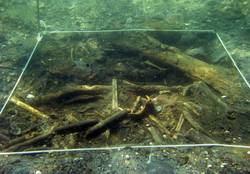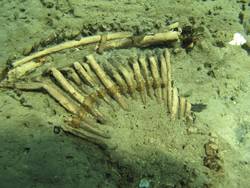Tools and techniques to raise waterlogged organic archaeological artefacts
Type of Activity: RTD
Objectives: Waterlogged organic artefacts can be extremely fragile, due to microbial deterioration processes (discussed in WP3). Therefore these types of remains can be challenging to excavate, support, raise and transport to conservation facilities. This is due to the inherent difficulties of working underwater (limited time and potentially harsh conditions) and in particular the crucial stage of lifting artefacts from the seabed to the surface where mechanical damage can easily occur. Submerged prehistoric sites, in particular, contain a wealth of the aforementioned organic materials and complex structures such as fish traps (Figure 20).
To overcome this, artefacts are often raised on supporting materials or in sediment blocks (block lifting), whereby the artefact is excavated with surrounding sediment and subsequently excavated under controlled conditions on land in the laboratory. Methods of encapsulating and block lifting have been used in the past to address this, yet can be very time consuming underwater, with artefacts being left exposed to physical damage at crucial stages while consolidating materials are allowed to “set” underwater. The objective of
WP5 is to:
• To develop and demonstrate new technologies to stabilize and consolidate fragile and complex organic archaeological on the seabed in order to facilitate their raising and transport to conservation facilities.



